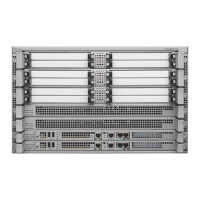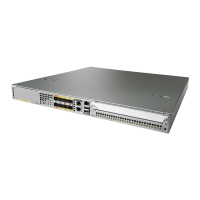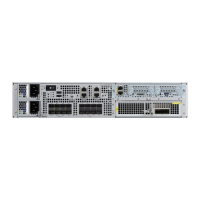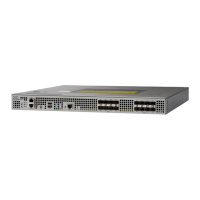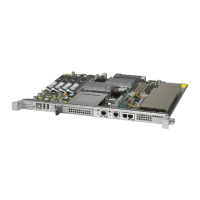13-2
Cisco ASR 1000 Series Aggregation Services Routers SIP and SPA Software Configuration Guide
OL-14127-08
Chapter 13 Configuring the POS SPAs
Configuration Tasks
• slot—Specifies the chassis slot number in the Cisco ASR 1000 Series Routers where the SIP is
installed.
• subslot—Specifies the slot of the SIP where the SPA is installed.
• port—Specifies the number of the individual interface port on a SPA.
The following example shows how to specify the first interface (0) on a SPA installed in the first subslot
of a SIP (0) installed in chassis slot 2:
Router(config)# interface serial 2/0/0
This command shows a serial SPA as a representative example, however the same slot/subslot/port
format is similarly used for other SPAs (such as ATM and POS) and other non-channelized SPAs.
For more information about identifying slots and subslots, see the “Identifying Slots and Subslots for the
SIP and SPAs” section on page 4-1.
Modifying the Interface MTU Size
The Cisco IOS software supports three different types of configurable maximum transmission unit
(MTU) options at different levels of the protocol stack:
• Interface MTU—Checked by the SPA on traffic coming in from the network. Different interface
types support different interface MTU sizes and defaults. The interface MTU defines the maximum
packet size allowable (in bytes) for an interface before drops occur. If the frame is smaller than the
interface MTU size, but is not smaller than three bytes of payload size, then the frame continues to
process.
• IP MTU—Can be configured on a subinterface and is used by the Cisco IOS software to determine
whether fragmentation of a packet takes place. If an IP packet exceeds the IP MTU size, then the
packet is fragmented.
• Tag or Multiprotocol Label Switching (MPLS) MTU—Can be configured on a subinterface and
allows up to six different labels, or tag headers, to be attached to a packet. The maximum number
of labels is dependent on your Cisco IOS software release.
Different encapsulation methods and the number of MPLS MTU labels add additional overhead to a
packet. For example, for an Ethernet packet, SNAP encapsulation adds an 8-byte header, dot1q
encapsulation adds a 2-byte header, and each MPLS label adds a 4-byte header (n labels x 4 bytes).
Interface MTU Configuration Guidelines
When configuring the interface MTU size on the POS SPAs, consider the following guidelines:
• If you are also using MPLS, be sure that the mpls mtu command is configured for a value less than
or equal to the interface MTU.
• If you change the interface MTU size, the giant counter increments when the interface receives a
packet that exceeds the MTU size that you configured, plus an additional 24 bytes for overhead, and
an additional 2 or 4 bytes for the configured cyclic redundancy check (CRC).
For example, with a maximum MTU size of 9216 bytes, the giant counter increments:
–
For a 16-bit CRC (or FCS), when receiving packets larger than 9306 bytes (9216 + 24 + 2).
–
For a 32-bit CRC, when receiving packets larger than 9308 bytes (9216 + 24 + 4).

